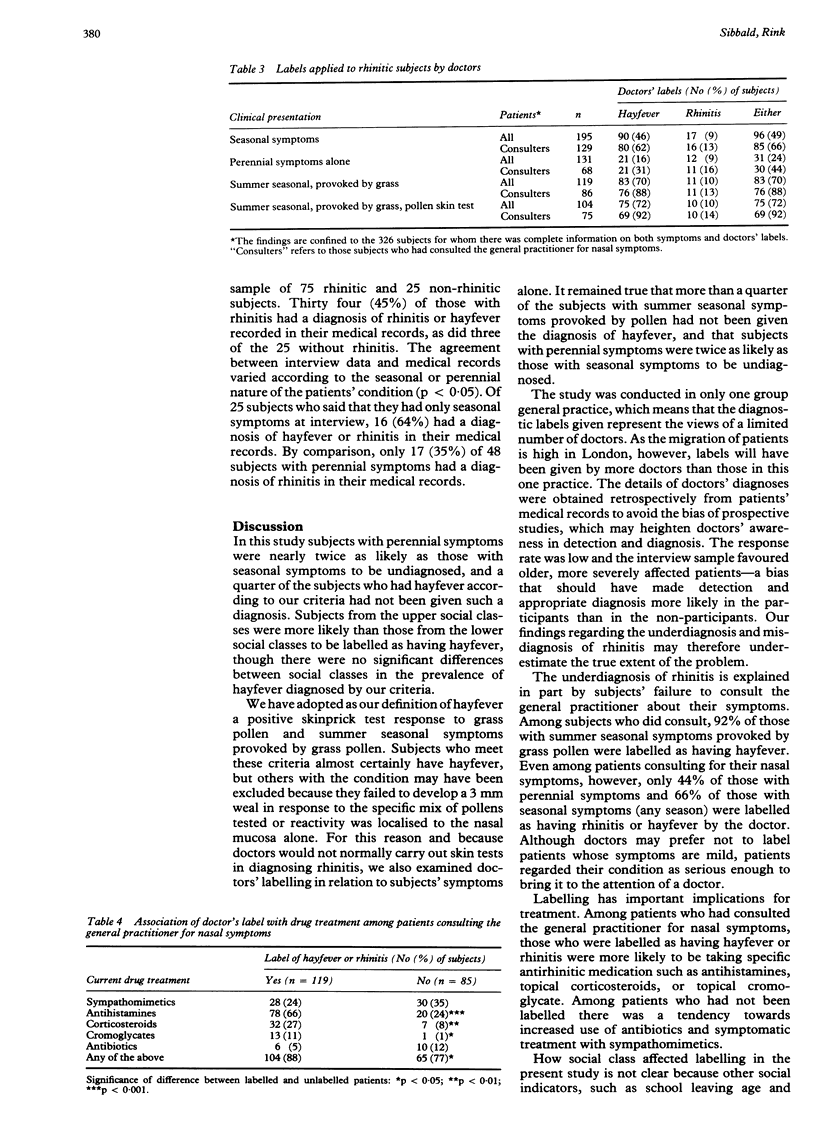Abstract
Factors influencing the labelling of rhinitis by doctors were examined in 7702 adults, aged 16-65 years, registered with a group general practice in south London. Individuals with rhinitis were identified by a postal screening questionnaire. Of the 2969 (39%) subjects who replied, 1309 (44%) reported rhinitis. A sample of 340 individuals with and 126 without rhinitis was studied, each being interviewed and having allergy skinprick tests. The information given at interview was compared with that recorded in the medical notes for 75 patients with rhinitis, selected at random to include 25 with seasonal symptoms only, 25 with perennial symptoms only, and 25 with both seasonal and perennial symptoms, plus 25 control subjects. Hayfever was defined as seasonal symptoms provoked by grass and a positive skin test response to grass pollen. Subjects with seasonal symptoms were nearly twice as likely as those with perennial symptoms to be labelled as having rhinitis by their doctor. More than a quarter of the subjects fulfilling our definition of hayfever had not been diagnosed as having hayfever. Subjects from the upper social classes were more likely than those from the lower social classes to be labelled as having hayfever, though there were no significant differences between social classes in the prevalence of hayfever according to our definition. It is concluded that rhinitis is frequently underdiagnosed and misdiagnosed. Increased detection of hayfever could account for the steep rise in consultation rates seen in recent decades.
Full text
PDF



Selected References
These references are in PubMed. This may not be the complete list of references from this article.
- Broder I., Higgins M. W., Mathews K. P., Keller J. B. Epidemiology of asthma and allergic rhinitis in a total community, Tecumseh, Michigan. 3. Second survey of the community. J Allergy Clin Immunol. 1974 Mar;53(3):127–138. doi: 10.1016/0091-6749(74)90001-3. [DOI] [PubMed] [Google Scholar]
- Emanuel M. B. Hay fever, a post industrial revolution epidemic: a history of its growth during the 19th century. Clin Allergy. 1988 May;18(3):295–304. doi: 10.1111/j.1365-2222.1988.tb02872.x. [DOI] [PubMed] [Google Scholar]
- Fleming D. M., Crombie D. L. Prevalence of asthma and hay fever in England and Wales. Br Med J (Clin Res Ed) 1987 Jan 31;294(6567):279–283. doi: 10.1136/bmj.294.6567.279. [DOI] [PMC free article] [PubMed] [Google Scholar]
- Littlejohns P., Ebrahim S., Anderson R. Prevalence and diagnosis of chronic respiratory symptoms in adults. BMJ. 1989 Jun 10;298(6687):1556–1560. doi: 10.1136/bmj.298.6687.1556. [DOI] [PMC free article] [PubMed] [Google Scholar]
- Peckham C., Butler N. A national study of asthma in childhood. J Epidemiol Community Health. 1978 Jun;32(2):79–85. doi: 10.1136/jech.32.2.79. [DOI] [PMC free article] [PubMed] [Google Scholar]
- Taylor B., Wadsworth J., Golding J., Butler N. Breast feeding, eczema, asthma, and hayfever. J Epidemiol Community Health. 1983 Jun;37(2):95–99. doi: 10.1136/jech.37.2.95. [DOI] [PMC free article] [PubMed] [Google Scholar]
- Weeke E. R. Epidemiology of hay fever and perennial allergic rhinitis. Monogr Allergy. 1987;21:1–20. [PubMed] [Google Scholar]


